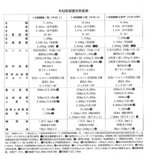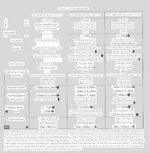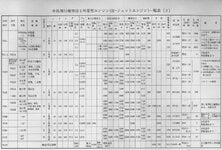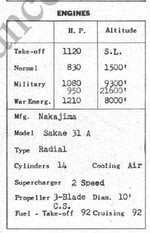its not a secret that
Ki-43-II used the Ha-115 engine
Ki-43-III used the Ha-115-II engine
However the data for Ha-115-II is all over the place…
Here are the figures I'm getting for Ha-115-II
A. 1150hp take off power
B. 1190hp take off power
-
A. 1100hp at 2850m
B. 1230hp at 2800m
-
A. 980hp at 6000m
B. 950hp at 6800m
Source A: Engine History of Nakajima Aircraft
Source B: Technical Colonel Ankai
C. Wikipedia even claims the figure of 1210hp, boosted by water-methanol injection, I've also seen 1300hp elsewhere.
The Issue I have with Nakajima Table is the fact that Ha-115 is rated 1130HP take off power, 1100hp at 2850m, 980hp at 6000m and Ha-115-II is also 1100hp at 2850m, 980hp at 6000m but with 1150HP take off power. Barely any difference. It claims the only difference is methanol injection. However Ki-43-III Ko which is heavier achieves a lot better rate of climb than Ki-43-II at military power (no methanol injection used)
Issue I have with Colonel Ankai is that the Ki-43-III Ko Top Speed is rated 555-560km/h at 6000m, whilst it claims the 2nd stage peaks at 6800m. If this was the case…. Ki-43-III Ko top speed would be at higher altitude than 6000m, however at the same time the table shows that Ki-43-III has superior performance at 8000-9000m, could that also be the side effect of the "rocket effect", or is the power at that altitude just better?
My Speculation that they probably only differ in terms of maximum power (W-M Injection) whilst military power is identical.
Ha-115 has 1130hp take off power
Ha-115-II has 1230-1300hp take off power
-
Everything military power wise is the same and that the performance difference between Ki-43-II Ko and Ki-43-III Ko at military power is probably due to the fact that Ki-43-III has individual exghaust pipes for each cylinder which is aimed backwards giving it a "rocket effect" as it did for A6M5's and the fact that Ki-43-III Ko is probably also more aerodynamic than the Ki-43-II Ko.
More about rocket effect is here:
 ww2aircraft.net
ww2aircraft.net
——
Ki-43-II Ko vs Ki-43-III Ko
Ki-43-II used the Ha-115 engine
Ki-43-III used the Ha-115-II engine
However the data for Ha-115-II is all over the place…
Here are the figures I'm getting for Ha-115-II
A. 1150hp take off power
B. 1190hp take off power
-
A. 1100hp at 2850m
B. 1230hp at 2800m
-
A. 980hp at 6000m
B. 950hp at 6800m
Source A: Engine History of Nakajima Aircraft
Source B: Technical Colonel Ankai
C. Wikipedia even claims the figure of 1210hp, boosted by water-methanol injection, I've also seen 1300hp elsewhere.
The Issue I have with Nakajima Table is the fact that Ha-115 is rated 1130HP take off power, 1100hp at 2850m, 980hp at 6000m and Ha-115-II is also 1100hp at 2850m, 980hp at 6000m but with 1150HP take off power. Barely any difference. It claims the only difference is methanol injection. However Ki-43-III Ko which is heavier achieves a lot better rate of climb than Ki-43-II at military power (no methanol injection used)
Issue I have with Colonel Ankai is that the Ki-43-III Ko Top Speed is rated 555-560km/h at 6000m, whilst it claims the 2nd stage peaks at 6800m. If this was the case…. Ki-43-III Ko top speed would be at higher altitude than 6000m, however at the same time the table shows that Ki-43-III has superior performance at 8000-9000m, could that also be the side effect of the "rocket effect", or is the power at that altitude just better?
My Speculation that they probably only differ in terms of maximum power (W-M Injection) whilst military power is identical.
Ha-115 has 1130hp take off power
Ha-115-II has 1230-1300hp take off power
-
Everything military power wise is the same and that the performance difference between Ki-43-II Ko and Ki-43-III Ko at military power is probably due to the fact that Ki-43-III has individual exghaust pipes for each cylinder which is aimed backwards giving it a "rocket effect" as it did for A6M5's and the fact that Ki-43-III Ko is probably also more aerodynamic than the Ki-43-II Ko.
More about rocket effect is here:
Ki-43-II 'Oscar 2' performance differences
Ki-43's had different Nose designs... As you may recall... A6M3 Clipped with 1130hp engine achieved 545km/h at 6000m A6M5 had same wing area and the same engine and intially achieved also 545km/h at 6000m max speed. The first 200 A6M5's didnt get the individual exghaust pipes for each...
——
Ki-43-II Ko vs Ki-43-III Ko
Attachments
Last edited:




